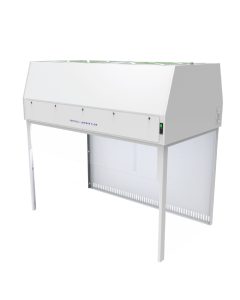The Difference Between Horizontal and Vertical Laminar Flow Cabinets
No matter what industry or sector you’re working in, understanding the function and benefits of a laminar flow cabinet is key to a contaminant-free environment.
In this blog, we’ll explain what a laminar flow cabinet is and how it works, the difference between vertical and horizontal, and how you can choose the right cabinet for your cleanroom.

What is a Laminar Flow Cabinet & How Does it Work?
Air that consistently moves at the same speed and in the same direction is known as laminar airflow. Also known as a laminar flow unit or laminar flow hood, a laminar flow cabinet uses laminar airflow to remove contaminant particles from an enclosed space. Using either HEPA (high-efficiency particulate air) or ULPA filters (ultra-low penetration air) to filter the air, air moves in a single direction with little to no turbulence, creating a controlled environment where contamination risks are minimised.
A laminar flow cabinet works by using a filtration system to direct clean, filtered air over a work surface in a smooth, unidirectional laminar (parallel) flow, which removes airborne contaminants and prevents external particles from entering the workspace. Due to its complete filter coverage, laminar flow cabinets create an ultra-clean environment, which is much easier to do in a smaller space as equipment, movement and personnel operating the space understandably cause turbulence that disturbs airflow.
Vertical Laminar Flow Cabinets
 As the name suggests, vertical laminar flow cabinets are designed with a vertical airflow pattern where the air is drawn from the top of the cabinet, through the filters, flowing vertically down onto the work surface and eventually out of the front access area. This workflow is ideal for applications that involve working with delicate samples or equipment such as electronics assembly.
As the name suggests, vertical laminar flow cabinets are designed with a vertical airflow pattern where the air is drawn from the top of the cabinet, through the filters, flowing vertically down onto the work surface and eventually out of the front access area. This workflow is ideal for applications that involve working with delicate samples or equipment such as electronics assembly.
Vertical laminar flow cabinets are often chosen for their size, layout and user safety.
With the filter at the top of the unit, the vertical laminar flow cabinets require less floor space but can be taller to accommodate taller objects.
Considerations when using a vertical laminar flow cabinet include:
- Overhead clearance may be required for changing and servicing the filter.
- There may be increased work surface turbulence due to vertical air hitting a perpendicular surface.
- Products and materials could potentially obstruct airflow when stacked.
This type of laminar flow cabinet is often chosen for applications including pharmacies and microbiology.
Horizontal Laminar Flow Cabinets
 In contrast, horizontal laminar flow cabinets feature a horizontal airflow pattern, where the air is blown parallel to the work surface, via the HEPA or ULPA filter from the back of the cabinet towards the user, until it exits the enclosure, providing the highest protection from contaminating particles.
In contrast, horizontal laminar flow cabinets feature a horizontal airflow pattern, where the air is blown parallel to the work surface, via the HEPA or ULPA filter from the back of the cabinet towards the user, until it exits the enclosure, providing the highest protection from contaminating particles.
This horizontal design eliminates the turbulence caused by vertical air striking perpendicular surfaces or the user’s hands, as they are always downstream from the materials they are working on, although the hood’s size, filter’s positioning and the airflow’s direction can sometimes cause issues depending on the processes undertaken within the LFU.
Considerations when using a horizontal laminar flow cabinet include:
- The hood may require repositioning to gain rear access for filter changes and servicing.
- Objects can obstruct the flow and contaminate anything downstream.
- Users could potentially suffer from fume or powder contaminants blowing at them if they don’t use the sash opening correctly.
Choosing the right laminar flow cabinet for your cleanroom
Both the vertical and horizontal laminar flow cabinets are very effective at reducing contamination, although some applications are better suited to one product over the other. Factors including location, clearance requirements, material size and work surface design are crucial in determining the ideal choice.
Vertical laminar flow cabinets are a particularly great choice for large or potentially hazardous material applications, whereas horizontal laminar flow cabinets are generally used in applications requiring minimal work surface turbulence and a high level of contamination control.
Our dedicated, experienced team can support you in choosing the correct laminar flow cabinet for your cleanroom environment, so be sure to contact us. If you know the product you need for your space, shop directly with our cleanroom consumables division, Cleanroomshop today.